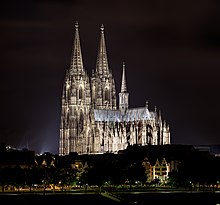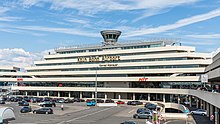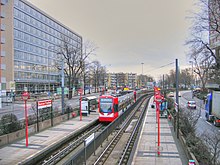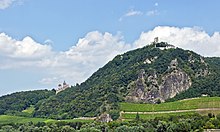Cologne Lowland (German: Kölner Bucht) is a region in North Rhine-Westphalia, Germany, centered around the cities of Cologne and Bonn on the river Rhine. With around 3 million inhabitants, it is one of Germany's most populated areas, and it houses many institutions of national and global stature, including world-renowned universities, federal institutions and business headquarters. Thanks to that and its excellent connectiveness, it sees one of Germany's highest numbers of visitors, both arriving in specific interests and casual tourists.

Cities
[edit]
- 1 Bonn - the erstwhile federal capital with a number of museums, cultural institutions and corporate headquarters, and a charming old town where Beethoven was born
- 2 Brühl - a leisurely town between Cologne and Bonn, home to UNESCO-listed palaces and a major amusement park
- 3 Cologne (Köln) - the largest city in North Rhine-Westphalia
- 4 Bad Honnef – the end of the Middle Rhine Valley
- 5 Königswinter - a hilly summer resort on the Rhine, with a hotel made famous as a residence for the federal government's guests
- 6 Leverkusen - a new town that boomed in the 19th century around chemical works, now also famous for its football team
- 7 Sankt Augustin - a town between Siegburg and Bonn, with an unusual castle
- 8 Siegburg - the seat of the county covering most of the lowland, famous for its ceramic beer pitchers, with a handy high-speed railway station serving Bonn
Other destinations
[edit]Understand
[edit]While named and centered around Cologne, the region is far more than just the city and its suburbs, with many interesting destinations outside of it, particularly Bonn. Densely populated and urbanized, it is however much less industrialized than Lower Rhine and Ruhr, as well as very green. It provides a nice, relaxed counterbalance to those, and serves as the state's hub for cultural events.
Continually inhabited since ancient Roman times, the region has a rich history, a wealth of monuments of which can be found all over. Furthermore, an exceptional number of museums present the region's history as well, and far beyond that, a startling variety of subjects with world-class exhibits.
Talk
[edit]Traditionally, Cologne has had a peculiar dialect, that might be hard to understand to even fluent foreign speakers of German. In practice, however, the language used in everyday matters by most is simply regular Hochdeutsch (standard German), with perhaps a few regionalisms in terms of vocabulary. The presence of a large migrant population from both other regions of Germany and other countries has helped to standardize German.
As Cologne is a university town and an international business and cultural hub, and Bonn the former capital, you will find most people conversant in at least English, and many other languages spoken as well.
Get in
[edit]
By plane
[edit]The main airport in the region is Cologne-Bonn Konrad Adenauer Airport (CGN IATA) in Cologne, connected to the region's light rail system, as well as Germany's high-speed train system - however only some high-speed trains passing through Cologne stop there. It is also well-connected to other European airports thanks to being the main hub for Eurowings, the low-fare short-haul subsidiary of Germany's flag carrier Lufthansa.
Other airports close by with more traffic, including many intercontinental flights, are Düsseldorf Airport(DUS IATA) and Frankfurt Airport (FRA IATA). As Frankfurt is Germany's main air transportation hub (and a base of flag carrier Lufthansa), you will find direct connections there from all over the world. Thanks to an excellent high speed rail connection directly from the airport to both Cologne and Siegburg/Bonn, it is a very convenient entry point to the region despite being some 200 km away. You can actually travel on the train from FRA using your flight ticket, for more on integrated rail and air tickets see rail air alliances.

By train
[edit]Almost all domestic tickets and even some international tickets can be bought via the website of Deutsche Bahn, however they don't sell tickets for Thalys either online or at ticket counters.
- Köln Hbf – Thalys from Paris, ICE from Brussels and Amsterdam, IC/EC from Basel
- Brühl – RE, RB and Mittelrheinbahn, tram line 18 from Cologne and Bonn
- Bonn Hbf – IC/EC, RE, RB and Mittelrheinbahn
- Siegburg – ICE and S-Bahn

Get around
[edit]In terms of public transportation, the region is covered by Verkehrsverbund Rhein-Sieg, which provides a unified tariff system across all publicly-owned operators in the region. Those include the Kölner Verkehrs-Betriebe, whose Stadtbahn light rail network reaches far beyond the city of Cologne into neighbouring municipalities such as Brühl, Bergisch-Gladbach, Hürth and Leverkusen, and even reaching as far as Bonn. Bonn itself has its own Stadtbahn (with some shared lines with Cologne's), also serving Siegburg and Bad Godesberg. Long distance ICE and IC trains are however not included in the Verkehrsverbünde and thus of little use for local and regional travel but a good way to enter or leave the area.

See
[edit]The region's concentration of population and afflucene have been features for centuries, which left much heritage throughout and now continues to express itself in the number and quality of cultural institutions, as well as nightlife and culinary scene. Museums are actually quite evenly spread between Cologne and Bonn, due to the latter's federal role. The free-entry Haus der Geschichte in the latter city is worthy of special recommendation, while the former has a museum dedicated to the ancient Roman heritage of the city and area.
In terms of architecture, Cologne has the world-famous cathedral, but other historic buildings have been decimated by wartime destruction. Large royal palaces of Brühl and Bonn can rival the ones in France easily, while smaller towns such as Siegburg and Königswinter bring about a sweetened, affluent version of the photo-album-ready Germany, with the river Rhine, picturesque forested hills and cozy old towns.

The 321 metre high Drachenfels near Königswinter is probably the world's most frequently summited mountain and has been a subject of many romantic poems (including one by Lord Byron) and pieces of art. It is topped by a ruined castle, a newer castle dating to the 19th century and the Nibelungen hall, reminding of the Siegfried legend. It can be reached by a century-old cog railway.
Itineraries
[edit]When in Cologne, take a walk down the Rheinauhafen, the city's redeveloped former harbour area to enjoy views over the Rhine and some spectacular modern architecture.

Do
[edit]There is plenty to do in the region, from taking the cruise on the river Rhine to enjoying many cultural activities throughout the year. The highlight is of course the colourful Cologne carnival, which gathers crowds from all over the world every November through February/March.
Drink
[edit]
The Cologne region is known for its local beer style called Kölsch, a top-fermented, fair-coloured brew containing just under 5 % alcohol. It is very light and smooth, making Germans from other regions who are used to the sharper Pils joke that it's "not even beer". It is usually served in slim 0.2 l glasses (so-called Stange, literally "stick") and should always be drunk freshly tapped as it gets stale very quickly. Waiters typically carry the small Kölsch glasses in a "wreath" (Kranz). In some Kölsch pubs or beer cellars, patrons are served a glass of Kölsch by default if not explicitly ordering a different drink, and are supplied with the next glass as soon as the former is empty, unless they explicitly refuse by putting a beermat on their glass.
Just like the traditional rivalry between Cologne and Düsseldorf, there is a long-cherished aversion of Kölsch drinkers against the Lower Rhine region's Alt beer (top-fermented as well, but darker and more malty flavoured), and vice versa. Ordering an Alt in a pub south of the Kölsch-Alt frontier (that runs through Grevenbroich, Dormagen and Monheim) is considered a gaffe and will be answered with ignorance or a sarcastic comment at best. Reportedly, some Kölsch enthusiasts even replace the Alt key on their computer keyboard by a Kölsch key.


